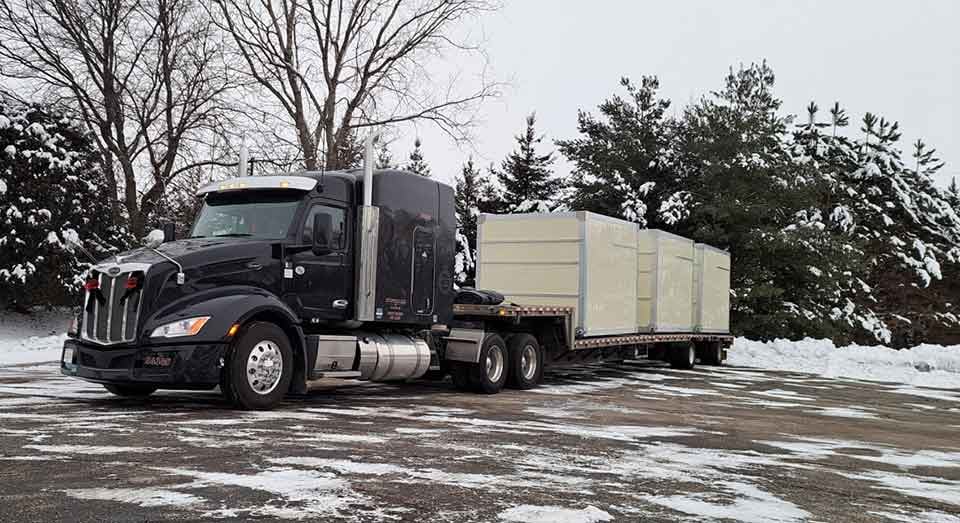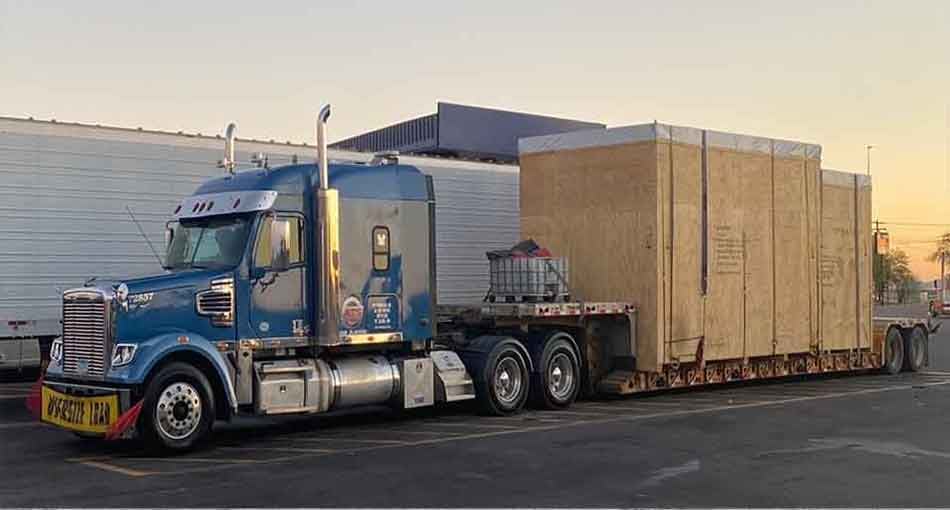So you’ve contracted with a freight carrier, and they have indicated that they will be using a step-deck trailer. What does that mean? Will the freight arrive safely to your destination? How does the carrier determine which type of trailer is best for your particular freight?
The trucking industry has an almost unlimited amount of jargon and industry terms — including the types of vehicles used during transit. It can seem daunting when you hear how your freight will be hauled without really understanding what that means.
At Anderson Trucking Service (ATS), we’ve been in the trucking industry for more than 65 years. We’re fluent in the jargon and work with customers on freight of every shape and size. And we use step-deck trailers and their alternatives every day. Most importantly, we want you to understand and feel comfortable with how your cargo will be moved.
In this article, we will cover:
- What is a step-deck trailer?
- Is there more than one type of standard step-deck trailer?
- Are there other alternatives to step-deck trailers?
- What are step-deck trailer dimensions?
- What are the advantages of step-deck trailers?
- What are the disadvantages of step-deck trailers?
- How to work with your flatbed shipping carrier
What Is a Step-Deck Trailer?
A step-deck trailer is also known as a drop-deck trailer. A step-deck is similar to a standard flatbed (open-deck) trailer, with one important difference.
A flatbed trailer is 5 feet high. A standard step-deck has a front platform that is five feet high – but the majority of the length of the trailer (more on length later) is 3 feet, 6 inches high.
Why is the lower deck height important? Depending on where you are in the country, the legal height limit ranges from 13 feet, 6 inches to 14 feet, 6 inches. If you are carrying tall freight (including high cube containers), you are likely to need the extra height that a step-deck trailer allows to move the load legally.

Is There More Than One Type of Step-Deck Trailer?
A low-profile step-deck trailer is the same style of trailer placed on smaller-diameter tires. A low-profile step-deck trailer is only three feet off the ground.
The additional six inches lets the carrier legally move even taller freight such as machinery, equipment or building commodities.
What Are the Alternatives to Step-Deck Trailers?
If the cargo is over the legal height for a step-deck trailer, there are some alternative options.
Double-Drop Trailers
Double-drop trailers are five feet tall at the front of the trailer, and three feet six inches at the back of the trailer. The center well (typically 26-30 feet long) is 18-24 inches off the ground — lower than both a step-deck and low-profile trailer.

A double drop trailer is ideal for freight that is tall but not as long, or has some length that can rest on either the front or rear deck, such as attachments on construction equipment.
Low-Profile Trailers
Low-profile step-deck trailers are typically 24 inches off the ground and are suitable for the tallest freight. To get this additional height, low-profile trailers are heavier and shorter than other types of trailers.
Low-profile step-decks are considered specialized equipment, which means an extra cost. Most shippers will prefer to use a standard step-deck rather if possible.
No matter which type of trailer you need, the carrier matters. Download the Freight Carrier Selection Checklist to vet your carrier now.

What Are Step-Deck Trailer Dimensions?
Standard step-deck trailers, like other flatbed trailers or dry vans, are 8 feet, 6 inches wide. Wider freight is considered overdimensional and will require additional permits.
The two most common lengths of step-deck trailers are 48 feet or 53 feet. Additional permits are needed for 53-foot step-deck trailers with overhang (freight that extends beyond the length of the trailer), so specifying the length of your freight is important to make sure it will fit within the legal limits.
What Are the Advantages of Step-Deck Trailers?
The most important advantage of a step-deck trailer is it allows you to move freight that is too tall for a flatbed trailer legally.
Compared to dry vans or other enclosed vehicles, step-decks also have additional flexibility for loading and unloading: they are accessible by crane and forklift. For especially large items that can not be driven onto the deck, this can save valuable time at the point of origin and destination.
What Are the Disadvantages of Step-Deck Trailers?
Step-deck trailers are often necessary because of the size of freight to be transported. But understanding the disadvantages of this type of vehicle is important to make sure you fully understand how your cargo will be transported.
Open to the Elements
Unenclosed trailers, including flatbeds, drop decks and double-drop trailers, leave your freight exposed to outside conditions. While this may not matter for equipment meant to be used outside, some cargo may need to be covered during transport. Tarping is one way to cover your freight during transit.
Lower Weight Capacity
Step-deck trailers typically are heavier than flatbed trailers. Because weight limit requirements are based on the total weight of the trailer and freight, this leaves lower weight capacity available for the freight.
Unable to Use Loading Docks
Loading and unloading cargo onto a step-deck trailer can be more challenging compared to a flatbed trailer. Flatbed trailers are at the height of the loading dock. The step or drop in the deck height of a step-deck trailer requires the use of ramps, forklifts, or loading equipment to adjust for the height difference.
Understanding the pros and cons of a step-deck trailer is one way you can work toward a successful shipment. Working with your carrier is the next step.
How to Work With Your Flatbed Shipping Carrier
No matter what type of trailer will carry your load, selecting the right carrier will help your trip go smoothly from start to finish.
When you decide on a carrier, specify the exact length, width and height of your cargo as soon as possible – during the first conversation, if you can. Accurate dimensions will help the carrier determine:
- Type of trailer required. The exact height of your freight will dictate if a standard flatbed, step-deck or low-pro is the best option for the trip. Even a five-inch difference can result in the wrong type of trailer being specified at the beginning, leading to potential charges, such as a truck order not used (TONU).
- Amount of tarps required. Tarps applied by the driver are one way to protect your freight from the elements. Drivers will carry some tarps with them at all times, but knowing the exact dimensions of your freight will ensure the driver is prepared with the correct number and type of tarps (and help you avoid additional cost).
- Permitting requirements. Exact dimensions are important when moving overweight and over-dimensional freight. Each state, city and county may require separate permits for overdimensional freight, and actual dimensions/weight cannot exceed what is permitted. To avoid delays, trucking companies will order permits prior to loading. If incorrect dimensions or weights were given, permits will need to be reordered at your expense.
- Securements needed. Securements are the straps or chains that hold your freight to the trailer. Sharing the exact dimensions with the carrier from the beginning will ensure the correct securements are provided before the driver arrives. The commodity to be transported should also be specified, as that will help determine the needed securements.
Other information you will want to discuss with your carrier may include:
- How the freight will be loaded and unloaded. If a crane, forklift or other heavy equipment will be needed, it’s important to plan for that.
- Insurance and liability. Discuss insurance coverage and liability arrangements with the trucking company. Understand their insurance policies, cargo coverage, and any additional insurance requirements you may have.
Working with an experienced freight shipper means that you can rely on their expertise, without needing to become an expert in every type of trailer and the capabilities and requirements of each.
Working With a Freight Carrier Using a Step-Deck Trailer
While you’ve probably seen step-deck trailers without knowing it (and now you will recognize them when you share the road), understanding the different types of trailers and how they are used gives you an advantage when working with a freight carrier.
To learn more about different trailer types you may see on the road, check out What Are Common Trailer Types Used in the Trucking Industry?



